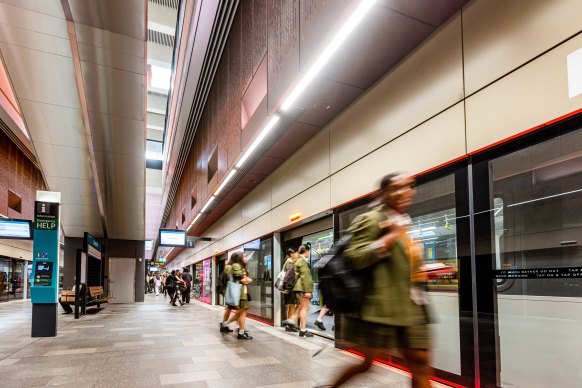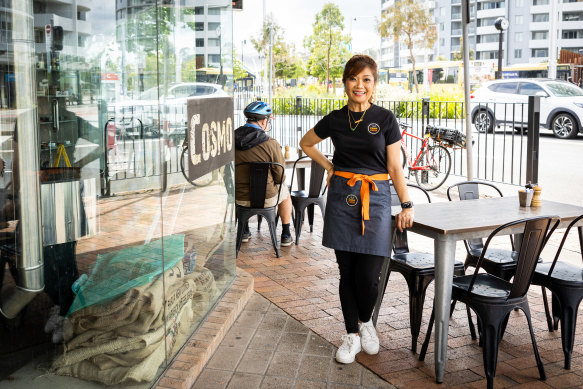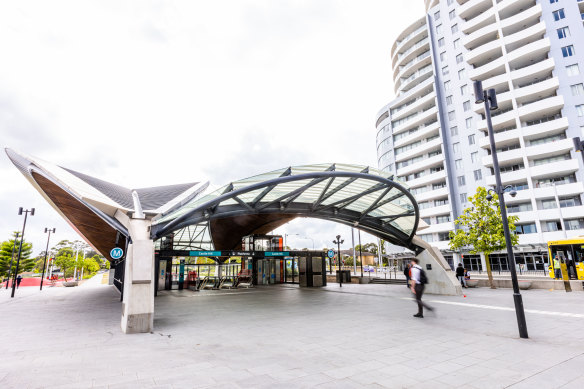This was published 2 years ago
‘Weekends are a lot busier’: Sydney’s first metro line bucks COVID trend
Commuters have flocked back to Sydney’s first driverless metro railway faster than other suburban rail lines since the pandemic led to a plunge in patronage across the rail network.
New figures also show stations on the Metro Northwest between Rouse Hill and Chatswood have climbed in the rankings against stations on other parts of the metropolitan rail network since the line opened in May 2019.

Commuters board a driverless train at Castle Hill station on the Metro Northwest line.Credit: Ben Symons
There were also more weekend trips by people using the 36-kilometre metro link to get to and from shopping areas in Sydney’s north-west.
In contrast, the existing double-decker train network is a long way from fully recovering from a slump in patronage during the worst of the pandemic. Town Hall station – still the city’s busiest – was down 46 per cent to about 54,400 people a day in October compared with three years earlier.
At Central Station, about 52,460 people a day passed through the ticket gates in October, down from almost 96,000 passengers in the same month in 2019. The average daily numbers reflect passengers who tap on and off at ticket gates using Opal cards and mobile devices.
Metro Northwest, the first of a four-stage metro network in Sydney costing $63 billion, avoided disruptions from a protracted dispute between the state government and rail unions last year which dogged the rest of the rail network.
Average daily passenger numbers at Tallawong station – at the northern end of the new line – rose 6 per cent to 2588 in October, from three years earlier, while other Metro Northwest stations fell 10 to 24 per cent.
More than 3400 passengers a day passed through gates at Castle Hill, making it the busiest new station on the line, and taking it from 65th to 48th place in the rankings over the past three years. That puts it in the same league as Campbelltown and Seven Hills train stations.
Maria Pirie, who works at Cosmo Coffee cafe near Castle Hill station, said the area had become busier since the metro line opened more than three years ago. “On the weekends it is a lot busier because people catch the metro here to visit. Some come from Rouse Hill,” said Pirie, a Castle Hill resident for the past 16 years. “Metro is really, really handy – it is fast.”
Tallawong station climbed in the rankings to 59th last year, from 108th in 2019, while Rouse Hill rose to 77th from 121st and Castle Hill to 48th from 65th.

Cosmo Coffee staff member Maria Pirie near the entrance to the new Castle Hill metro station.Credit: Ben Symons
Blends and Brothers barber Virushan Pradheepan agreed the metro line was encouraging more people to travel to Castle Hill. “It is a good thing – travelling around is so much quicker,” he said.
Sydney transport expert Mathew Hounsell said patronage on the $7.3 billion Metro Northwest would be boosted when the main section of the Metro City and Southwest line from Chatswood to North Sydney, the CBD and beyond opened next year.
“We always knew the line to Chatswood wouldn’t be enough. Once you get to North Sydney and the CBD that is when [the metro network] really becomes the game changer,” he said.
However, Hounsell said greater urban density to fully realise the benefits of the Metro Northwest rail corridor had yet to follow suit, due in part to council resistance and land banking.
Developer lobby group Urban Taskforce said some developments had emerged in areas near the metro stations, but more apartment buildings were needed in parts of the north-west dominated by detached homes.
“These metro lines are very expensive ... and shouldn’t just be a benefit for those lucky enough who live around them. You have to leverage that benefit by increasing housing, employment, height and density,” Urban Taskforce chief executive Tom Forrest said.
Forrest, who was a senior RailCorp executive from 2008 until 2011, said the Metro Northwest had been remarkably successful from an operational perspective since it began services more than three years ago.
Transport Minister David Elliott, who is the MP for Baulkham Hills in Sydney’s north-west, said greater density along the rail corridor was “always going to be a consequence” of the metro line.

Castle Hill is the busiest new station on the Metro Northwest line.Credit: Ben Symons
“As much as I want to make sure it’s limited so the character of the suburbs in north-western Sydney is not jeopardised, we do have to accept there will be some density around these stations,” he said.
Elliott said it had never been a condition that high-density housing was the price locals paid for a new rail line, but it was one way to help address a “broader housing crisis” in Sydney.
Sydney University urban planning professor Nicole Gurran said the government needed strategies to ensure affordable homes were built along rail corridors.
Otherwise, she said the benefits of better accessibility through improved transport pushed up house prices and rents, forcing people on lower incomes further out to the city’s fringe. “Density doesn’t translate to affordability, nor does making lower value areas more accessible. Overseas, when transformative projects like a new metro line are planned, you embed a housing affordability strategy from day one,” she said.
Although patronage is still at about three-quarters of pre-pandemic levels, Sydney Metro chief executive Peter Regan said the Northwest line had “very strong” growth at weekends, when people were using it to travel between centres.
“Once the city section [of the metro network] opens, we’ll see a lot more of that because there’s the speed, the frequency, the reliability,” he said.
With Nigel Gladstone
The Morning Edition newsletter is our guide to the day’s most important and interesting stories, analysis and insights. Sign up here.